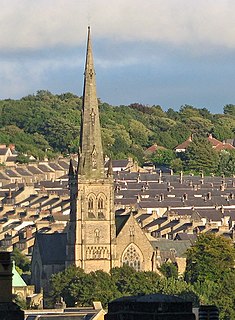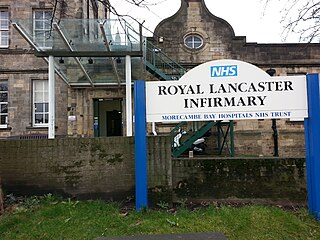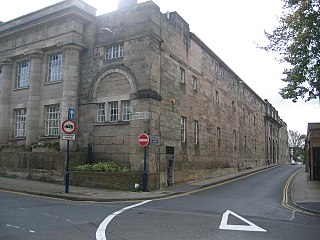
Kensington is an affluent district in the Royal Borough of Kensington and Chelsea in the West of central London.

The flag of France is a tricolour flag featuring three vertical bands coloured blue, white, and red. It is known to English speakers as the French Tricolour or simply the Tricolour. The Tricolour has become one of the most influential flags in history, with its three-colour scheme being copied by many other nations, both in Europe and the rest of the world, and, according to the Encyclopædia Britannica has historically stood "in symbolic opposition to the autocratic and clericalist royal standards of the past.

Lancaster (,) is a city and the county town of Lancashire, England. It stands on the River Lune and has a population of 52,234. The wider City of Lancaster local government district has a population of 138,375. The House of Lancaster was a branch of the English royal family, whilst the Duchy of Lancaster holds large estates on behalf of Elizabeth II, who is also the Duke of Lancaster. As an ancient settlement, it is marked by Lancaster Castle, Lancaster Priory Church, Lancaster Cathedral and the Ashton Memorial. It is home to Lancaster University and has a campus of the University of Cumbria.

Fulford is a historic village and civil parish on the outskirts of York, England. Two miles (3 km) to the south of the city, on the east bank of the River Ouse, it was the site of the 11th century Battle of Fulford. The population of the civil parish at the 2011 census was 2,785.

Lancaster Cathedral, also known as The Cathedral Church of St Peter and Saint Peter's Cathedral, is in St Peter's Road, Lancaster, Lancashire, England. It was a Roman Catholic parish church until 1924, when it was elevated to the status of a cathedral. It started as a mission church in 1798, and the present church was built on a different site in 1857–59. It was designed by E. G. Paley in the Gothic Revival style. In 1901 a baptistry was added by Austin and Paley, and the east end was reordered in 1995 by Francis Roberts. The cathedral is in active use, arranging services, concerts and other events, and is open to visitors. The building is recorded in the National Heritage List for England as a designated Grade II* listed building.

The Western Heights of Dover are one of the most impressive fortifications in Britain. They comprise a series of forts, strong points and ditches, designed to protect the country from invasion. They were created in the 18th and 19th centuries to augment the existing defences and protect the key port of Dover from both seaward and landward attack; by the start of the 20th century Dover Western Heights was collectively reputed to be the 'strongest and most elaborate' fortification in the country. The Army finally withdrew from the Heights in 1956-61; they are now a local nature reserve.

Larkhill is a garrison town in the civil parish of Durrington, Wiltshire, England. It lies about 1 3⁄4 miles (2.8 km) west of the centre of Durrington village and 1 1⁄2 mi (2.4 km) north of the prehistoric monument of Stonehenge. It is about 10 mi (16 km) north of Salisbury.

Aldershot Garrison, also known as Aldershot Military Town, is a major garrison in South East England, located between Aldershot and Farnborough in Hampshire. Established in 1854, Aldershot is the home of the British Army although smaller than in previous years. The garrison was established when the War Department bought a large area of land near to the village of Aldershot, with the objective of establishing a permanent training camp for the British Army. Over time, this camp grew into a military town and continues to be used by the Army to the present day. It is home to the headquarters of the Army's Support Command, and it is also the administrative base for the 101st Logistic Brigade. The garrison plays host to around 70 military units and organisations.

'Warwick Camp' was originally the rifle ranges and a training area used by units of the Bermuda Garrison based elsewhere in the colony. Today, the Camp is the home of the Royal Bermuda Regiment.

Michael Willetts, GC was one of the first British soldiers to be killed during the Troubles in Northern Ireland, and the recipient of a posthumous George Cross for his heroism in saving lives during the Provisional Irish Republican Army bombing which claimed his own. The Harvey Andrews song "Soldier" commemorates Willetts' sacrifice.

The Royal Lancaster Infirmary (RLI) is a hospital in the city of Lancaster, England. It lies to the south of the city centre, between the A6 road and the Lancaster Canal. It is managed by the University Hospitals of Morecambe Bay NHS Foundation Trust.

The Drill Hall Library in North Road, Chatham, was built as a military drill hall in 1902, for the Royal Navy as part of HMS Pembroke shore establishment and barracks. After the barracks closed in 1984. The Grade II listed buildings of the barracks, which include the Captain's House, a Mess block, the Pilkington Building, the four barrack blocks, the Gymnasium, and the surrounding walls of barracks were then redeveloped as part of the Universities at Medway, a tri-partite collaboration of the University of Greenwich, the University of Kent and Canterbury Christ Church University on a single campus. The three universities share use of the Drill Hall Library.

The Norfolk Militia was formed under the Militia Act of 1757, replacing earlier less formal arrangements. From this date, better records were kept, and the men were selected by ballot to serve for longer periods. Proper uniforms and better weapons were provided, and the force was 'embodied' from time to time for training sessions.

The Royal Marine Depot, Deal was a military installation occupied by the Royal Marines and located in South Deal, Kent, on the road to Walmer. The Depot was first established in Deal in 1861, occupying part of the Royal Naval Hospital. In 1868 the Depot expanded and took over the nearby 18th-century Army barracks.
The Lancashire Militia was an auxiliary military force in Lancashire in North West England. From their formal organisation as Trained Bands in 1558 and their service in the Williamite War in Ireland and against the Jacobite Risings, the Militia regiments of Lancashire served during times of international tension and all of Britain's major wars. They provided internal security and home defence but sometimes operated further afield, including Ireland and the Mediterranean, relieving regular troops from routine garrison duties, and acting as a source of trained officers and men for the Regular Army. All the infantry battalions went on active service during the Second Boer War and all served as Special Reserve training units in World War I, with one battalion seeing considerable action on the Western Front. After 1921 the militia had only a shadowy existence until its final abolition in 1953.

The Old Barracks is a former military installation in Sandon Road, Grantham. It is a Grade II listed building.

The Old Barracks is a former military installation in Barrack Road, Warwick, England. It is a Grade I listed building.

The Old Barracks is a former military installation in Barrack Road, Newcastle-under-Lyme, England. It is a Grade II listed building.

Preston Town Hall is a municipal building in Lancaster Road in Preston, Lancashire, England. The town hall, which is the headquarters of Preston City Council, is a Grade II listed building.
The 1st Royal Lancashire Militia was an auxiliary regiment raised in the county of Lancashire in North West England during the 17th Century. Primarily intended for home defence, it saw active service in Ireland under King William III, as well as against the Jacobite Risings of 1715 and 1745. It spent long periods on defence duties during the wars of the 18th Century and early 19th Century, and was stationed on the Ionian Islands during the Crimean War. It later became part of the King's Own and saw active service in the Second Boer War. After conversion to the Special Reserve under the Haldane Reforms it supplied reinforcements to the fighting battalions during World War I. After a shadowy postwar existence the unit was finally disbanded in 1953.



















